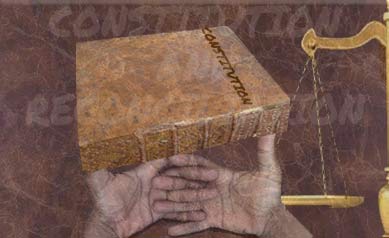Constitutional Reform And Reconciliation

Introduction:The major division of thoughts in philosophy is the relationship between “being” and “thinking” and the definition of what the world is consisting of – in primary instance. Materialism claims that, in the first instance – the world is just “a matter in motion” and our mind, awareness, and thoughts are secondary property of matter. Idealism on the other hand claims that, there is no such “material world”. The world in first instance is our “mental process, mind, and thoughts” – and that what we perceive is not “an entity on itself” but created by the mind.
In the same breath and philosophical language, I will give you a sketch – as to what the relationship between “constitutional reform” and “reconciliation” and their primary instance in the Eritrean Political process as we go forward to create a stable and peaceful “Eritrean state.” But before I proceed to the topic at hand, I will give you a small illustrative sketch, that has served as a “political vignette” in the transitional period, including the constitutional process and the outcome of the process. I characterized the transitional period of the 1997 constitutional process as the “Carthaginian peace” purported for the subjugation of ELF organization and its supporters, and by extension to the Eritrean people as whole. What is the Carthaginian peace in the Eritrean political landscape then? And what are the consequences of that peace treaty? To answer those questions, I will try to show the historical process of its becoming, its purpose, and the negative seeds sown to our diversity. Furthermore, I will try to hint the unifying factor for the current struggle and how we could strengthen the coexistence of our diversity.
The ‘Carthaginian Peace’ Of Eritrean Politics
The “Carthaginian peace” is the outcome of a series of wars –the “Punic wars” between Rome and the Phoenician city of “Carthage,” with the goal to impose a “brutal peace” and enslave its population. Now in modern politics, Carthaginian peace is referred to any brutal peace treaty demanding total subjugation of the defeated adversary and their supporters.
The Eritrean national liberation was fought by two organizations namely the ELF and EPLF. These two organizations had fought a series of civil wars against each other, to dominate the field and the political power. The civil war ended in 1981 with the defeat of ELF organization. Unfortunately, EPLF declared the “Carthaginian peace” in early 90s by banning any political organization, demanding full subjugation to its adversary ELF organization and its bases within the Eritrean population. The Eritrean people blindfolded by the success of EPLF organization, failed to see the forthcoming of the afterwards, that they will also be subjugated to the whim of the organization and its leaders. Now the Eritrean people are fighting to abolish the Carthaginian treaty between PFDJ and and the Eritrean people the “brutal peace” that enslaved the whole population.
These author is more concerned on the aftermath of the fall of the current authoritarian regime than on how to strategize the current struggle to expedite the fall of the regime. I am concerned on how to confront the past and face the future, in order not to let history to repeat again. Henceforth, this article will focus on “constitutional reform” and “reconciliation” as the way forward to resolve the intricate Eritrean politics.
When we debate Constitutional reform and reconciliation, usually comes the issue of “primary instance” and the philosophical relationship between them, akin to “materialism vs idealism”. I have debated this issue with my Eritrean compatriots rigorously on, one on one or in a group format several times. And here, I will share my view with the public, and hoping to contribute and stimulate constructive engagement on this vital political process, to determine the future of our country. Before I spell out my positions and the argument I was making, a little historical background is paramount to help our deliberation.
Confronting The Past And Facing The Future
The issue of reconciliation could be seen from two contextual perspectives (a) transition from authoritarian rule to democracy (b) transition from war to peace. In our modern era, we have witnessed many transitions to democracy – that are prevailed in Southern Europe in 1970, in Latin America in 1980, and in Africa and Eastern Europe in 1990. The process to peace and democracy is therefore, could be rapid as in the case of Greece in 1970, or slow and partial as in the case of Chile in 1990. Equally, the depth and the pace of the process also depend on the proximate variables of the conflicts. As a result, the process could be catalyzed by external intervention as in a case of Iraq, or by way of negotiation and formal participation of United Nation as in a case of Guatemala, or by negotiation but without the formal participation of United Nation as in the case of Ghana, or with broad concession of Amnesty as in the case of Sierra Leone.
In all the cases I mentioned, it shows that each of them has a unique character, dictated by the variables around them and the peculiarity of their make up. But, despite their differences in the process they went through, they often wrestle with similar moral, legal, and political challenges. History attest that nations emerged from armed struggle or authoritarian regime are usually suffer from massive violation of human rights, as in the case of Eritrea.
To confront the legacy of violations, the new transitional governments must establish “transitional justice” as in the case of Sri Lanka. The purpose of transitional justice, is therefore squarely to confront legacies of abuse in a holistic manner, within the legal institutions, comprising criminal justice, restorative justice, social justice, and economic justice. The transitional justice must also recognize the policy that seeks measures to achieve accountability for past crimes and the prevention of new crimes. The criminal justice will adjudicate its duty and recognize that the action and measures deemed to be taken should balance to the need of peace, democracy, equitable developments, and rule of law.
Transitional justice has four accountability tools (a) trials – be it civil or criminal (b) fact finding bodies that include “truth commission” – national or international (c) reparations – be it compensatory, restitutive, or rehabilitative (d) reform of justice – includes reform of law, institutions, and personnel’s. In the implementation mechanisms of transitional justice, “the fundamental and critical issue that must be given priority is the victims right to truth and justice [Bhavani Fonseka & Luwie Ganeshathasan, 2016]. In forming the hybrid transitional justice, there are many non partisan national and international organizations (NGOs) that could play a great deal in framing the mechanisms of transitional justice and the process of reconciliation.
Apriori Reasoning: Constitutional Reform VS Reconciliation
The material world we live in, is made up of pairs of opposites. And therefore, our thoughts are evolved from those pairs of opposites of material and spiritual worlds, thereby framing the debates of opposites in the real world. As in the contextual debates of pairs of opposites of Materialism versus Idealism, regarding which comes first, there are also similar debates in every pairs of opposites.
For sometimes I have debated with friends and colleagues on the requirements of constitutional reform and reconciliation, and how their priority should set in motion one after the other in future Eritrea.
Now, the question is, how can we truly reconciled, while our social groups and political groups (organizations) continue to exist in a relatively disadvantaged and also continue to remain on the margins of social and political spectrum of our society? Therefore, in order our society to be reconciled, something has to be done as a prerequisite to challenge the trust-deficit that looms within our diversity. In my view and for starters, constitutional reform will lesson the current trust-deficit and pave the road to national reconciliation.
In the heated debate, my argument was and is pivoted, that in the presence of history of exclusion, constitutional reform precedes reconciliation “to reframe and reset our relationship as a nation and to establish new relationship that opens our hearts and minds” [ Mick Gorda, 2011], to bring harmony and equity in the sociopolitical and socioeconomic lives of our society. Reconciliation is the process of repairing a relationship so that re-engagement, trust, and cooperation become possible after transgression or violation [Wilmot and Hecker, 2011, pp 323]. The whole purpose of reconciliation is therefore, as “family of actions intended to break or prevent destructive cycles of human interactions” [Bright and Exline, 2009, pp-1].
Reconciliation does not dismiss or minimize the harm that was incurred in the past nor will be indifferent about justice. Reconciliation is about acknowledging the truth of what happened without providing excuse to the behaviors of individuals that causes the harm. But, instead make them accountable for their actions. As Lederach explained, reconciliation is where justice and peace have kissed each other [Lederach, 1998, pp-22].
As a matter of fact, some notable historical references could be a teaching moment to our reality. Mashingaidze, referring to the healing and reconciliation project of Zimbabweans, had to say this: Zimbabweans have failed to heal and reconcile after major crises, because the national leadership accorded premium to the state-sanctioned ideal of forgiveness without truth, and reconciliation without justice [Mashingaidze, 2010, pp-21]. Ideally, the 2012, Turkey constitutional reform model seem to fit and good to start with, that includes the formation of “constitutional reconciliation commission” with numbers of subcommittees in it. Once a reconciled constitutional document is produced and ratified by the National Assembly, then follows the process of reconciliation and the popular election of National leaderships, both for the legislative and chief executive offices as deemed in the constitution and the election laws. Please note, that my argument is bounded and or limited to the process, its model, and its philosophical approach; and thus, the details is left out to the constitutional reconciliation commission (CRC).




Awate Forum